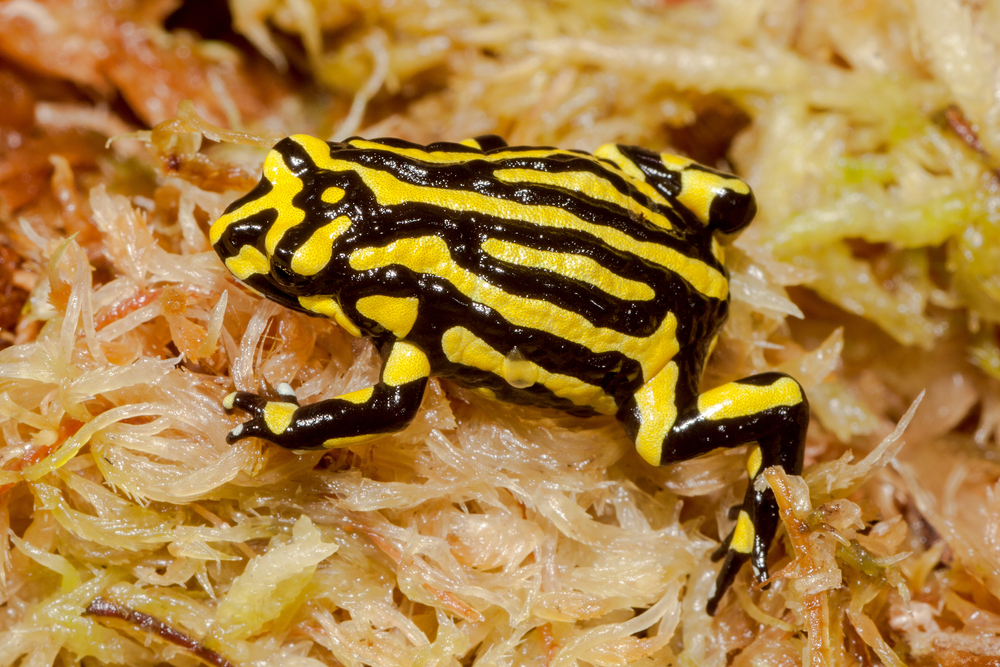Frogs Kick Back Against Lethal Fungus
Posted on Categories Discover Magazine

More than three decades ago, amphibian researchers from around the globe converged on Canterbury, England, for the first World Congress of Herpetology — and, over drinks, shared the same frightening tale.
Frogs were disappearing in the wild, and no one could explain why.
It was “a scary time,” recalls Australian veterinary scientist Lee Berger, who in the 1990s was one of the first to identify the culprit: a water-borne chytrid fungus known as Batrachochytrium dendrobatidis, or Bd.
Scientists know now that the stealthy menace originated in east Asia and was probably spread inadvertently by people to every continent except Antarctica.
The parasitic fungus can be as transmissible as it is lethal, wiping out entire populations of some frogs in a matter of weeks. And until recently it has proved largely unstoppable. Despite more than 25 years of intense study, conservationists haven’t devised a panacea that can prevent Bd infections or save populations of frogs after they contract the Bd-caused skin disease chytridiomycosis.
Bd has been implicated in the decline and possible extinction of around 200 frog species.
Yet today, Berger and other researchers see grounds for optimism. There’s evidence that some frogs are naturally evolving resistance. Scientists are also trying to exploit the fungus’s sensitivity to temperature by building Bd-free habitats or moving frogs to locales where the fungus can’t survive. Still others are investigating viruses that attack Bd and eventually might be used to reduce its virulence. These innovative strategies are emerging like slimy glimmers of hope on an otherwise gloomy landscape.
Chytridiomycosis kills because skin is an integral part of a frog’s cardiovascular system. When chytrid fungus colonizes the skin, electrolytes can’t get absorbed. This disrupts the heart’s electrical rhythms, and the animals die of heart failure.
But though ruthlessly efficient at killing off some frog species, the fungus is highly vulnerable to heat: Temperatures above 30 degrees Celsius (about 85 degrees Fahrenheit) slow disease progression.
The armoured mist frog in the Wet Tropics of Queensland, Australia, appears to have shifted habitats, allowing it to take advantage of this fungal Achilles’ heel. The frog — thought extinct for almost 20 years — no longer dwells in shaded areas near the forest’s mountain waterfalls. But a population persists in warmer, sun-drenched areas. Perhaps that’s because the frogs can rest on sunbaked rocks through the night, which elevates their body temperatures enough to stave off Bd, says biologist Conrad Hoskin of James Cook University in Queensland.
(CREDIT: CONRAD HOSKIN)
An armoured mist frog warms itself on a wet rock. Once thought extinct, this species was rediscovered in locales where it has access to the Sun’s warmth, which can help frogs fight the often-deadly fungal infections.
Since 2013, Hoskin has been transplanting armoured mist frogs from the surviving population into new, similarly sunny habitats and closely monitoring the health of these new colonies.
In a larger effort, Hoskin and colleagues recently assessed the habitat ranges of 55 eastern Australian frog species, including 25 affected by Bd. They found that even though the fungus has curtailed the ranges of afflicted species, they are persisting in warmer lower elevations with more rain.
Other researchers have also tried moving groups of Bd-infected frogs, either to salvage dying populations or to spread recovering ones. Of 15 relocations attempted in Australia over the last 20-odd years, seven populations are holding on and three are thriving.
Providing frogs with amenities has also helped. Conservation biologist Anthony Waddle of Macquarie University in Sydney built heat shelters from large bricks prefabricated with holes that just happen to be the perfect size for green and golden bell frogs. Sick frogs that hung out in these “frog saunas” had lower infection loads than those that convalesced in the shade, Waddle and colleagues reported in 2024 in Nature.
(CREDIT: ANTHONY WADDLE)
Green and golden bell frogs take refuge in the warm confines of sun-soaked bricks. The higher temperatures help the frogs fight chytrid infections, and “frogs really like hanging out in little holes,” says University of Arkansas biologist Erin Sauer, a coauthor of the study on these frog saunas.
As this incremental progress continues, scientists are racing to figure out why some frog species are more susceptible to Bd than others. Conservation biologist Tiffany Kosch, who works with Berger at the One Health Research Group at the University of Melbourne veterinary school, is taking a genetic approach. Kosch recently sequenced the genome of the southern corroboree — a black and brilliantly yellow frog of which 50 or fewer survive in the wild. If the scientists can learn which particular versions of genes are associated with Bd resistance, they could breed and release resistant frogs, or even engineer Bd resistance into the southern corroborees.Researchers also have discovered a virus of fungi that appears to infect weaker strains of Bd — pathogens for the pathogen, in other words. While harnessing such viruses to help fight Bd is a long way off, it might one day be another weapon. “In the science fiction version, you spray the virus in the field and the frogs all survive — that’s the hope,” says University of California, Riverside, mycologist Jason Stajich, coauthor of a recent report on the virus in Current Biology.Berger, who coauthored an update on Australian frogs and Bd in the 2024 Annual Review of Animal Biosciences, says that that despite the losses, optimism is key to working in conservation. “You have to make a choice to focus on the positives.”Indeed, there’s a lot more work to be done to avoid further declines and extinctions, says ecologist Andrea Adams of the University of California, Santa Barbara. “We can’t afford to take a hands-off approach.”
10.1146/knowable-110624-1
Martin J. Kernan is a science writer from central New York who attributes his interest in slimy critters to spending many unsupervised hours as a kid elbow-deep in pond muck. This article originally appeared in Knowable Magazine, an independent journalistic endeavor from Annual Reviews. Read the original here.